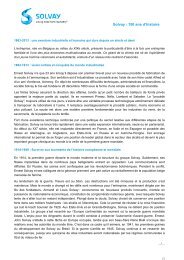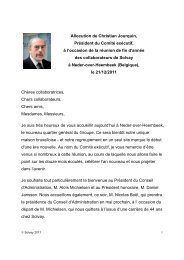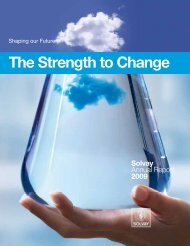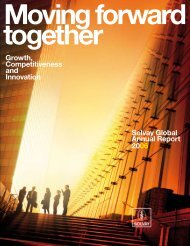solvay_live243_p02a04 somEdito
solvay_live243_p02a04 somEdito
solvay_live243_p02a04 somEdito
Create successful ePaper yourself
Turn your PDF publications into a flip-book with our unique Google optimized e-Paper software.
Dossier SolvayInnovationTrophy2006<br />
105017<br />
68<br />
FROM FLUORINATED BY-PRODUCTS THERMAL<br />
TREATMENT TO ANHYDROUS HF RECOVERY:<br />
THE WAY TO SWITCH FROM DISPOSAL COST TO PROFIT<br />
TURNING AN EXPENSE<br />
INTO A PROFIT<br />
Traditionally, manufacturing units that<br />
produce fluorinated specialties are equipped<br />
for the thermal treatment of by-products.<br />
This operation is generally followed by water<br />
washing of the off-gases. The solution<br />
that emerges from this process is then<br />
neutralised, precipitated and the solid<br />
substratum is buried. The demand for increased<br />
capacity of the Spinetta plant (Italy),<br />
and greater cost cutting called for the design<br />
of a new thermal treatment section.<br />
This new treatment hinged on two<br />
technologies: high temperature burning<br />
reactors and recovering AHF (anhydrous<br />
hydrofluoric acid). The solution is a thermal<br />
treatment reactor producing gaseous HF<br />
followed by a sector allowing the recovery<br />
of hydrofluoric acid, on anyhydrous form.<br />
This new process generates significant profits<br />
as it recovers the spent AHF directly in the<br />
process, eliminating the costly process of<br />
neutralizing and land-filling the waste. Full<br />
capacity production was tested with good<br />
results, but the full benefit will only be felt<br />
when Spinetta (Italy) achieves the planned<br />
increase in capacity. The operational costs<br />
are offset by the savings made on the<br />
neutralisation operations. Moreover, important<br />
savings are made on the HF recovered during<br />
the process as well as on the treatment and<br />
maintenance operations. More importantly,<br />
the reduction in solid waste by landfill usage<br />
delivers significant environmental<br />
improvements.<br />
> Antonio Bertani; Paolo Ricci; Federica Rusconi.<br />
> SBU SPECIALTY POLYMERS<br />
101885<br />
DAY-CARE CENTER ”SOLKIDS” IN HANOVER<br />
CONCILIATE PROFESSIONAL<br />
AND PRIVATE LIFE<br />
More than 500 women are employed<br />
on Solvay’s Hanover site, i.e. over<br />
50% of the total number of employees, a<br />
proportion that is higher than the average of the<br />
other Solvay sites. Among these women are a<br />
large number of highly qualified scientists or<br />
marketing managers. More often than not,<br />
German women take a career break to devote<br />
three to six years to raising their family, even<br />
though this means that it is difficult to maintain<br />
their skills at the required level. One of the<br />
reasons for this is the lack of government<br />
subsidies for nurseries and day-care facilities for<br />
children under the age of six. According to a<br />
survey conducted in 2003, there is a strong<br />
demand among mothers of young children for<br />
nursery and day-care facilities. Management<br />
decided to meet the demands of these women<br />
and one of the buildings on the Hanover site has<br />
been completely rebuilt and equipped to house<br />
childcare facilities that comply fully with health<br />
and safety standards. The day-care center opened<br />
its doors in December 2004 with opening hours<br />
from 7.30 a.m. to 5.30 p.m. and it has grown with<br />
the children, as in 2006 a floor opened reserved<br />
to “big kids” from the ages of three to six years.<br />
At the end of the first business year the balance<br />
sheet proved that the financial investment<br />
was rewarded: to fill a position with a new<br />
employee costs about EUR 25 000. During<br />
the first year seven employees could return<br />
to their job after only some months of maternity<br />
leave and five employees returned from<br />
home-office employment, i.e. cost saving due<br />
to no need for new employment was higher<br />
than the yearly operation cost of Solkids<br />
which are EUR 170 000 per year.<br />
Thus Solkids became a win-win institution for both:<br />
• mothers, who want to continue to work.<br />
They are very satisfied and motivated;<br />
• Solvay, who is no longer losing its home-grown skills.<br />
> Brigitte Borchers; Detley Hofmann; Cornelia Kuester;<br />
Manuela Martin; Herbert Roehrle; Ulrike Sander;<br />
Petra Schmidt-Graubner; Axel Tegge; Martin Varchmin;<br />
Sven Zymelka.<br />
> BSC GERMANY<br />
Sustainable Development & citizenship




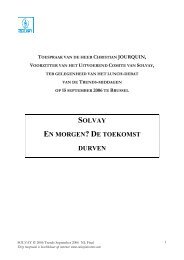
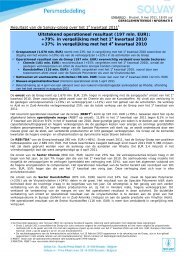

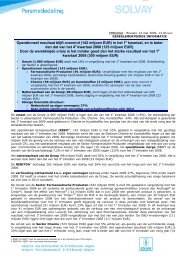


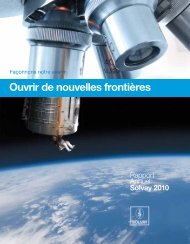
![PROC.1 [LETTRE] - Solvay](https://img.yumpu.com/16585746/1/184x260/proc1-lettre-solvay.jpg?quality=85)
